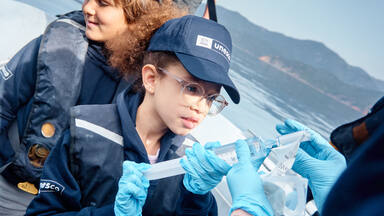UNESCO brings together World Heritage marine site managers to review groundbreaking environmental DNA Expeditions and citizen science efforts
On 30 April 2025, managers from the 51 UNESCO World Heritage marine sites convened online with experts from UNESCO to review the results of UNESCO’s pioneering environmental DNA (eDNA) expeditions initiative and to exchange first-hand experiences involving citizen scientists in this world-first effort.
UNESCO eDNA expeditions is the first global use case for detecting ocean biodiversity with citizen-science using shared eDNA collection approaches. Over three years, more than 250 volunteers, some as young as 6 years old, collected eDNA samples at 21 UNESCO World Heritage marine sites spread across 19 countries. This effort empowered local schoolchildren and communities to contribute to marine biodiversity research and understand the impacts of climate change on their local World Heritage marine site.
The goal of the online meeting was to share lessons learned and firsthand insights with UNESCO World Heritage marine site managers - both from sites that participated in the initiative and those that did not - on how eDNA, combined with citizen science, can enhance marine biodiversity monitoring in protected areas, especially in the face of climate change threats to the ocean.
The scientific coordinator of the initiative, based in the International Oceanographic Data and Information Exchange (IODE) office in charge of the UNESCO Intergovernmental Oceanographic Commission (IOC)’s Ocean Biodiversity Information System (OBIS), presented an overview of the eDNA expeditions initiative. The presentation highlighted global results from the 19 participating countries and outlined future plans to support continued eDNA sampling and citizen science engagement at UNESCO World Heritage marine sites. Published in December 2024, the global results revealed the identification of more than 4,400 marine species, including several species of sharks and rays, marine mammal species, and turtle species. Among these, 120 are listed as vulnerable, endangered, or critically endangered on the IUCN Red List. Remarkably, the eDNA campaign detected 10–20% of the expected local marine fauna at each sampling site—an outcome that, using traditional survey methods, would have required prolonged effort and substantial financial resources.
Another major outcome of the programme was a parallel climate impact analysis, which assessed the thermal limits of the detected species using projected future ocean temperature scenarios. The findings indicated that in some tropical regions, up to 100% of species may be affected, highlighting the urgent need for adaptive management in response to increasing thermal stress on marine life.
Managers from UNESCO World Heritage marine sites shared their experiences leading the local eDNA sampling campaigns. A representative from the Everglades National Park World Heritage site (United States of America) highlighted the value of eDNA as a complementary tool to traditional methods for monitoring species presence within the site. The UNESCO-supported eDNA sampling campaign engaged local high school students in hands-on sampling activities, bridging classroom learning with real-world conservation efforts. Parents joined in as well, further strengthening community involvement. Currently, eDNA is used in the park to monitor overall biodiversity, including detecting invasive species like Burmese pythons.
Meanwhile, the iSimangaliso Wetland Park World Heritage site (South Africa) shared how the eDNA campaign marked a first for both the site and local schools. High school students and teachers were trained in the techniques of eDNA sampling, with a strong emphasis on safety and following precise protocols. The campaign introduced learners to marine science and emphasized the importance of accuracy in data collection. As some key species were not detected, the campaign uncovered important data gaps and reinforced the importance of ongoing research and enhanced collaboration between marine protected area managers and the scientific community.
The UNESCO World Heritage List comprises 51 marine sites across 37 countries. Due to their status as the world’s flagship marine protected areas, UNESCO World Heritage marine sites are uniquely positioned to drive change and innovation, help set global standards in conservation excellence, and serve as beacons of hope in a changing ocean.
This online meeting was made possible with the support of the French Biodiversity Agency (OFB).




